Use 'Print preview' to check the number of pages and printer settings.
Print functionality varies between browsers.
Printable page generated Friday, 26 April 2024, 6:46 PM
Study Session 10 Extreme Weather Events
Introduction
You often hear on the radio and TV or in the newspapers that extreme weather events such as floods, storms and typhoons have affected hundreds of people and damaged buildings, water supplies and sanitation facilities. Extreme weather events are expected to increase in the future because of climate change. Knowing what extreme weather events occur in Ethiopia can help WASH workers plan and prepare to reduce the impacts.
In this study session you will look at what is meant by the term ‘extreme weather’ and learn about three types of extreme weather event that occur in Ethiopia: floods, droughts and heatwaves, and also about wildfires, which are not themselves weather events but are associated with very dry weather. Our focus in this study session is on the impact of these events on the environment and on WASH services. The impacts on human health, agriculture and the economy in Ethiopia are discussed in Study Session 11.
Learning Outcomes for Study Session 10
When you have studied this session, you should be able to:
10.1 Define and use correctly all of the key words printed in bold. (SAQ 10.1)
10.2 Describe the main types of extreme weather events in Ethiopia and how they affect the environment. (SAQs 10.1, 10.2 and 10.4)
10.3 Explain how natural climate cycles and human activities can increase the risk of extreme weather events in Ethiopia. (SAQs 10.2 and 10.3)
10.4 Describe how extreme weather events can affect WASH in Ethiopia, including in urban areas. (SAQs 10.3 and 10.4)
10.1 What is extreme weather?
You know from your own experience that the weather varies from day to day, month to month and year to year. Most of the time, these fluctuations occur within a normal range. Some periods are hotter, colder or wetter than others, but these variations are not unusual. Extreme weather events are periods of weather outside the normal range of weather conditions. For example, floods that happen because of excessively high rainfall, or droughts, or heatwaves and wildfires resulting from a period of unusually high temperature, are extreme weather events.
We expect certain weather in different regions of Ethiopia – hot and dry in the lowland areas, but cooler and wetter in the highlands. We expect some areas to flood and some areas to have drought from time to time. But if the weather conditions are extreme, then we have unexpected conditions to deal with. Study Session 9 concluded that low-income countries like Ethiopia generally lack the personnel, equipment, infrastructure and finances to deal with the effects of climate change and increasingly frequent extreme weather events.
Globally, there are many types of extreme weather events, but we will focus on floods, droughts, heatwaves and wildfires because they are the most likely to affect Ethiopia.
10.2 Floods
Floods are extreme weather events that have had major effects in Ethiopia at different times and in different locations. In recent decades, major floods outside the normal pattern of flooding have occurred in Ethiopia with increasing frequency (EM-DAT, n.d.). They have been responsible for many deaths of people and livestock, and caused damage to homes (Figure 10.1), livelihoods and infrastructure in many parts of the country (MoWR/NMA, 2007). Table 10.1 shows the costs of major flood events in 2005 and 2006, which were the worst in recent years in terms of deaths and economic damage in Ethiopia.
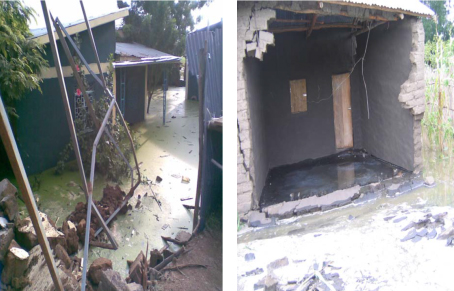
| Year | Region/towns affected | Human deaths | Total affected people | Costs due to flood damage ($US) |
| 2005 | Somali region, Dire Dawa and Wolayta zone, Humbo woreda | 211 | 242,418 | 6,200,000 |
| 2006 | Eastern Afar, Eastern Somali, Tigray, Gambela, Omo, Amhara and SNNPR regions; Dire Dawa city, Addis Ababa | 951 | 434,146 | 3,200,000 |
There are two main types of floods – flash floods and river floods – both of which affect water supply and sanitation.
10.2.1 Flash floods and their causes
Flash floods are floods that happen as a result of intense rainfall in a localised area and they usually drain away quite quickly (Few, 2006). If a large amount of rain falls onto the land in a short time and it cannot soak into (infiltrate) the soil, the water runs downhill across the land surface. This heavy flow of surface run-off can cause a flash flood.
There are many factors that increase the risk of flash floods in Ethiopia, including changes in land use and poor soil permeability (Abaya et al., 2009). As you read in Study Session 6, when forests and grasslands are removed for the construction of roads and buildings, permeable soil is replacedby hard surfaces such as concrete. This reduces the infiltration of water into the ground and increases run-off,making flooding more likely. The proportion of Ethiopia’s land area that is covered by forests has decreased significantly in recent decades, as Study Session 1 demonstrated (see Figure 1.3).
How do forests help rain to soak into the soil?
Forests play an important role in the water cycle because the roots of plants reach deep into the soil and create space between soil particles; this increases soil permeability, so when it rains the water can infiltrate the soil.
Failures of dams and reservoirs can also lead to flash floods. Many micro-dams have been constructed in Ethiopia for irrigation, water supply and generating hydroelectric power. Dam failure can occur if they are not properly constructed, or heavy rainfall may cause ‘overtopping’ (water flowing over the top of the dam when it is full).
Flash flooding has happened many times, in many parts of Ethiopia. This causes significant harm to human life and property because it happens so unexpectedly and local people are unprepared (Greenough et al., 2001). For example, the flash flood on 5 August 2006 in Dire Dawa caused 256 deaths and displaced 9956 people (Early Warning Department, Federal Disaster Prevention and Preparedness Agency, 2007).
10.2.2 River floods and their causes
River floods occur when the water level rises and water spills over the top of the river banks. The overflow runs into nearby low-lying areas, where it collects as flood water (Douben, 2006). River floods in Ethiopia generally occur because of intense heavy rain at high altitudes, which results in water flowing down into lowland rivers, which then burst their banks. Unlike flash floods, river floods tend to build up slowly, but they remain for much longer periods. Figure 10.2 shows river floods in Dire Dawa and Gambela.
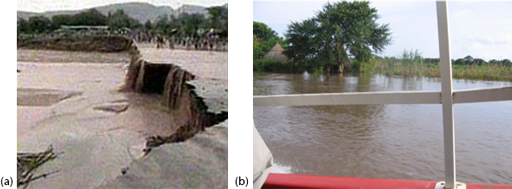
Look at the map in Figure 10.3. Which parts of Ethiopia are prone to flooding?
The main flood prone areas in Ethiopia are in the centre of the country in parts of SNNPR and Oromia, in the north in Amhara region and in the south-east in Somali region.
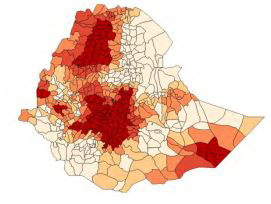
The impacts of river floods depend on many factors, such as the presence of early warning systems (Bonacci and Ljubenkov, 2008). There is no effective early warning system in place in most flood-prone areas of Ethiopia, but rural communities can reduce the impact, for example by moving livestock to higher ground at the start of the flood season. But this precaution is only effective for the normal intensity and frequency of floods – it cannot deal with unusually extreme flooding – and people in urban communities are usually unable to take any action to avoid flood damage.
The severity of flooding is increased by the absence of vegetation, intensive farming methods and deforestation, all of which increase soil erosion. Bare soil is more easily washed away by heavy rain than soil that is held together by the roots of trees and other plants. Soil erosion is the main cause of increased amounts of sediment in many Ethiopian reservoirs. As soil is washed off the land into the reservoir, sediment builds up behind the dam and it can significantly reduce the reservoir capacity, leaving the dam less able to withstand a major flood.
10.2.3 The impact of floods on WASH in Ethiopia
Floods often cause major damage to basic facilities such as water supplies, sanitation, waste disposal systems and other essential services. This poses a serious challenge to public health. Excessive rain and flooding can create conditions that increase the spread of faecal-oral diseases because flood waters flush pathogens and pollutants into water supplies from flooded latrines and places used for open defecation.
As well as polluting water sources, floods also can damage shallow wells, boreholes fitted with windmills, and protected springs, and they can wash away water pipes (Ethiopia Red Cross/Red Crescent, 2005). The result is that people are unable to access safe drinking water unless temporary water supplies can be provided (Figure 10.4).
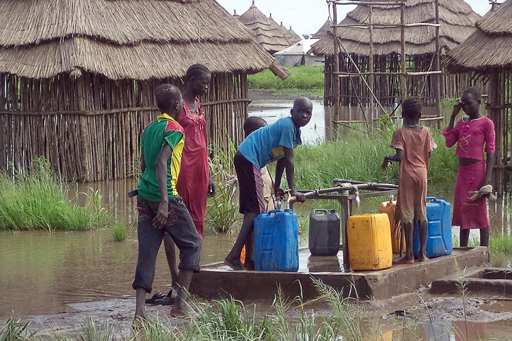
10.3 Drought
Drought is not a new word to many Ethiopians. Drought is the absence of rain for an extended period, often for a season or more. Climate change is associated with the significant reduction in rainfall and increase in droughts that is already apparent in some parts of Ethiopia. Droughts have caused loss of human life, livestock and property, as well as migration of people (MoWR/NMA, 2007).
More than 85% of the population of Ethiopia are farmers. Most of the agriculture in the country is small scale and therefore highly dependent on rainfall and traditional technologies. Drought affects agriculture by damaging crops and decreasing crop yield (Figure 10.5), which causes food shortages not only in rural areas but also in towns and cities. In the worst periods of drought there may be widespread famine, when the extreme shortage of food results in many deaths. The drought that occurred in 1984, leading to a famine that killed more than one million people, is still fresh in the memories of many Ethiopians.
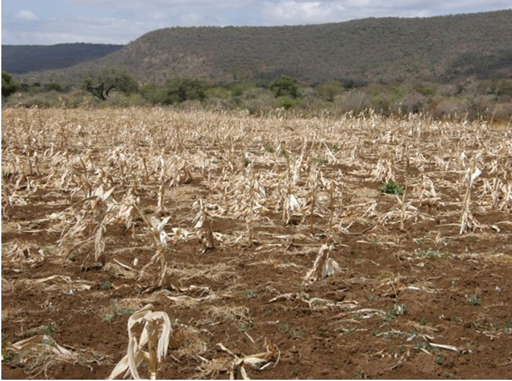
10.3.1 How many Ethiopians are affected by drought?
More than 57 million people across Ethiopia have been affected by droughts since 1980 (MoWR/NMA, 2007). Table 10.2 shows the frequency and impacts of droughts between 1964 and 2003.
| Years | Regions affected | Impacts on human life and property |
| 1964–66 | Tigray and Wollo | About 1.5 million people affected |
| 1973–74 | Tigray and Wollo | About 200,000 people and 30% of livestock dead |
| 1978–79 | Southern Ethiopia | 1.4 million people affected |
| 1982 | Northern Ethiopia | 2 million people affected |
| 1983–84 | Ethiopia | 8 million affected, one million dead and many livestock lost |
| 1987–88 | Ethiopia | 7 million people affected |
| 1990–92 | Northern, eastern, south-eastern Ethiopia | 0.5 million people affected |
| 1993–94 | Tigray and Wollo | 7.6 million people affected |
| 2000 | Ethiopia | 10.5 million people affected |
| 2002–03 | Ethiopia | About 13 million people needed food assistance. |
Look at Table 10.2. What trend over time do you notice in the impacts of drought and famine in the period shown?
The number of people affected by drought and famine has increased during this period, from 1.5 million in 1964–66 to more than 13 million in 2002–03.
Even though the population of Ethiopia has increased over the period from 1964 to 2003 (which could partly explain the increase in numbers affected), the later droughts covered larger areas of the country and were more severe. Currently more than 10 million people live in the drought-prone areas of Ethiopia shown in Figure 10.6.
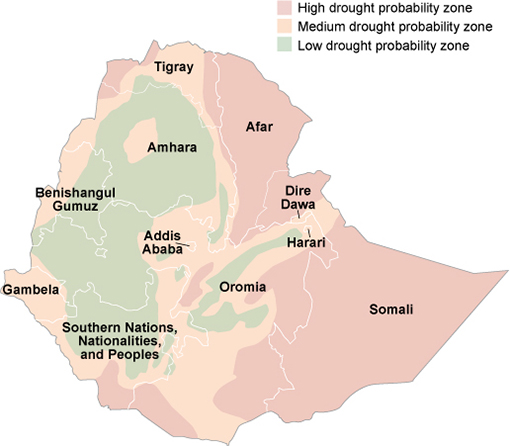
Based on Figure 10.6, which parts of Ethiopia are most vulnerable to drought?
The most drought-vulnerable areas in Ethiopia include Somali, Afar, parts of Tigray, eastern and southern Oromia, and southern SNNPR.
10.3.2 The causes of drought in Ethiopia
Global warming and alterations in rainfall patterns are believed to be the underlying cause of the trend towards more frequent and more severe droughts in Ethiopia (MoWR/NMA, 2007).
Can you suggest why a climate which is gradually becoming warmer will result in an increase in the risk of droughts? (Hint: think back to Study Session 9.)
Increased air temperature will heat the surface of water bodies and make the soil warmer, resulting in increased evaporation of water into the atmosphere. Also, as plants die through lack of water (remember Figure 10.5), large areas of bare soil are exposed to the heating effects of higher air temperatures, so even more water is lost through evaporation.
There are many other interlinked factors that cause droughts in Ethiopia. Between 1950 and 2014, the population grew from 18.1 million to 96.5 million people, so there has been a rapidly increasing demand for water to meet their needs (Figure 10.7). The rising standard of living, economic growth and industrial development all increase water demand because they require more water for additional uses. Particularly in urban areas, the demand for piped water and flush toilets has increased because households aspire to achieve higher standards of hygiene and sanitation.
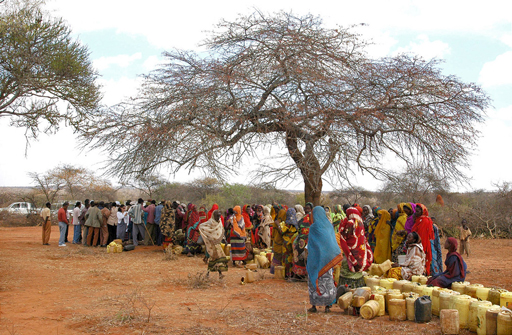
Population pressure also leads to high deforestation for agricultural expansion and to meet the growing demand for wood (Figure 10.8) to burn as fuel and also for building fences and houses.
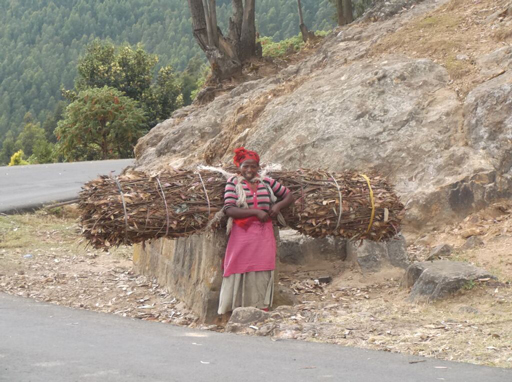
Summarise the ways in which forests sustain the water cycle and locally available water resources.
Forests play a crucial role in stabilising soils, reducing water run-off during rainy periods and increasing the amount of water stored underground. Shade from trees also reduces surface water evaporation and trees add moisture to the atmosphere through the process of transpiration. Thus, forests can be considered an important part of the water cycle and they contribute to sustaining the availability of water in the local area.
In summary, climate change leading to global warming and reduced rainfall, coupled with population pressure, deforestation and change in land use are all major factors in the increasing risk of drought in Ethiopia.
10.3.3 Impacts of drought on WASH in Ethiopia
As well as causing shortages of food and surface water, droughts have a significant effect on the availability of safe water resources. Drought causes water scarcity, so people are more likely to use unsafe water sources such as polluted rivers, streams and lakes. During times of water scarcity, people may save whatever water they can find for drinking and cooking, and stop using it for hygiene activities such as handwashing after defecation (Kovats et al., 2003). Drought can also increase the concentration of pathogenic organisms in rivers and lakes because the lower volume of water cannot dilute the contaminants to below the infectious dose (Kovats et al., 2003). We will discuss the impacts on human health in Study Session 11.
10.4 Heatwaves
Heatwaves are prolonged periods of unusually hot weather, which may or may not be accompanied by high humidity. The World Meteorological Organization definition of a heatwave is ‘when the daily maximum temperature on more than five consecutive days exceeds the average maximum temperature by 5 °C. The perception of a heatwave varies geographically because it is measured relative to the average temperature in that area. For example, weather that is experienced as normal heat in summertime in Gambela town would be considered a heatwave in Addis Ababa city, where the average summer temperature is much cooler.
Heatwaves are a big challenge in low-income countries like Ethiopia, because energy resources for cooling and air conditioning are often lacking. Heatwaves can cause adverse health effects and even death when severe dehydration of the body results from excessive sweating. It is very important to drink plenty of water during a heatwave to replace lost fluids. When heatwaves occur in areas of Ethiopia with water shortages, people cannot get enough water to drink or to cool themselves, so provision of an adequate and safe water supply is important to reduce the impacts on human health.
10.5 Wildfires
Nowadays wildfires are becoming increasingly common in the world because of frequent heatwaves and hot, dry conditions resulting from climate change. A forest fire is called a wildfire when it spreads very rapidly over a large area and is extremely difficult to bring under control (Figure 10.9). In many countries, including Ethiopia, the United States, Russia and Australia, wildfires are common during the dry season and especially in severe droughts. More than 200,000 hectares of forest are lost every year in Ethiopia because of fires (Kovats et al., 2003). Climate change is expected to increase the intensity and frequency of droughts in many parts of Ethiopia, increasing the risk of more severe and frequent forest fires.
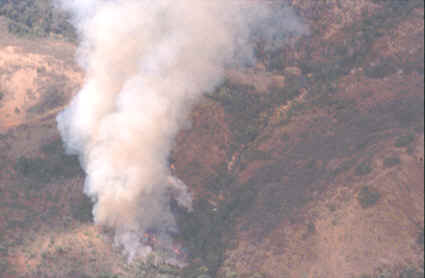
Wildfires are dangerous because they spread so quickly, destroying large areas of forest, damaging buildings and infrastructure, and killing any people, livestock and wildlife that cannot escape. Wildfires also have effects on human health through the emission of pollutants such as ash, toxic gases, dusts and debris into the atmosphere. Respiratory problems like asthma andbronchitis are made much worse if the air quality is contaminated with these products of burning vegetation.
Wildfires can also severely affect water quality. When the debris and ash are washed away by rain, they enter water sources such as rivers, streams and wells. The water can become cloudy with ash, taste or smell smoky or earthy, and contain toxic chemicals from burnt wood, which in turn can have adverse health effects if used for drinking (Waskom et al., 2013).
10.6 El Niño and La Niña
We conclude this study session by mentioning two natural climate cycles that can affect the location and frequency of extreme weather events around the world, including in Ethiopia. The rise in sea temperature that we described in Study Session 9 has widespread effects on ocean currents, particularly in the Pacific Ocean (National Weather Service, 2006). When the Pacific Ocean is unusually warm, it generates a climate cycle known as El Niño (‘little boy’ in Spanish); when the ocean temperature is unusually cool, the climate cycle is called La Niña (‘little girl’). El Niño and La Niña have opposite effects on the climate. Even though both of these ocean currents occur far away from Ethiopia, they influence the route and speed of major airstreams and alter the pattern of rainfall around the world, so that some regions are wetter than average and others are drier (Waskom et al., 2013).
The effects of El Niño and La Niña in Ethiopia depend on which of our two rainy seasons they occur in. The belg season is from February to March and the kirmit season is from June to September. If El Niño occurs during belg, it can cause above-normal rainfall, whereas if La Niña occurs during belg, it causes below-normal rainfall (FAO, 2014). In contrast, if El Niño occurs during kirmit, it decreases the seasonal rainfall, whereas La Niña during kirmit increases rainfall above the normal level (National Weather Service, 2006).
Would El Niño or La Niña occurring in the belg season increase the risk of floods or droughts in Ethiopia?
El Niño occurring in belg can cause above-normal rainfall, so the risk of floods increases. If La Niña occurs during the belg season, it causes below-normal rainfall, so the risk of droughts increases.
What effects would El Niño have on WASH if it occurred during kirmit?
It would decrease rainfall and increase the risk of droughts; this would result in water shortages, which may force people to drink water from unsafe sources and they may also stop using water for hygiene purposes.
What effects would La Niña have on WASH if it occurred during kirmit?
It would increase rainfall, which could cause more flooding. Floods can contaminate our water resources and destroy the water supply and sanitation facilities.
In the next study session, you will look in more detail at the impacts of climate change and extreme weather events on health, environments, agriculture, water resources and the Ethiopian economy.
Summary of Study Session 10
In Study Session 10, you have learned that:
- Extreme weather is weather that departs from the normal range of climate conditions.
- Floods, droughts, heatwaves and wildfires are the most common extreme weather events in Ethiopia.
- Flash floods develop rapidly and are due to the run-off of intense rainfall collecting in a localised area, usually for a short time. River floods occur when the water level rises and spills over the river banks; the build-up is generally slower than in a flash flood, but the extent is greater and the duration is longer.
- Floods cause major damage to basic facilities such as water supplies, sanitation and waste disposal systems; they contaminate water sources by flushing pathogens, soil and toxins into rivers, lakes, ponds and wells.
- Drought is the absence of rain for extended periods, often for a season or more. The frequency of droughts has increased over time in Ethiopia.
- There are many contributing factors to floods and droughts in Ethiopia, including population pressure, deforestation, climate change and the occurrence of natural climate cycles due to El Niño and La Niña currents in the Pacific Ocean.
- Drought has a significant effect on water resources and WASH; it causes water scarcity which in turn may lead people to use unsafe water sources.
- A heatwave occurs when the daily maximum temperature on more than five consecutive days exceeds the average maximum temperature by 5 °C.
- Climate change is expected to increase the intensity and frequency of drought in many parts of Ethiopia, in turn causing more severe and frequent heatwaves and wildfires.
- When debris and ash from the wildfires enter the atmosphere, they can cause respiratory problems; when they are washed into water sources by rain they can significantly reduce water quality.
Self-Assessment Questions (SAQs) for Study Session 10
Now that you have completed this study session, you can assess how well you have achieved its Learning Outcomes by answering these questions.
SAQ 10.1 (tests Learning Outcome 10.1)
Match the following words to their correct definitions.
Using the following two lists, match each numbered item with the correct letter.
El Niño
river floods
La Niña
extreme weather
flash floods
a.water spills over the top of the river banks into surrounding areas
b.unusually cool temperatures in Pacific Ocean currents
c.unusually warm temperatures in Pacific Ocean currents
d.intense rainfall causes water run-off to collect locally
e.weather outside the normal range of weather conditions
- 1 = c
- 2 = a
- 3 = b
- 4 = e
- 5 = d
SAQ 10.2 (tests Learning Outcomes 10.2 and 10.3)
Explain how each of the human activities described in (a) and (b) can increase the risk of flooding:
- a.constructing roads and urban areas on land previously used for agriculture
- b.deforestation.
Explain how each of the human activities described in (c) and (d) can increase the risk of droughts:
- a.population pressure
- b.deforestation.
Answer
- a.Urbanisation increases the risk of flooding because the paved surfaces and concrete constructions are impermeable and prevent rainfall from soaking into the soil as it used to do when the land was used for agriculture.
- b.Deforestation increases soil erosion because bare soil is more easily washed away by heavy rain when not held together by tree roots. Soil washed off the land builds up in reservoirs and rivers, significantly reducing their water-holding capacity, so they overflow during intense rainfall and flood surrounding areas.
- c.Population pressure increases the risk of droughts because there is increasing demand for water as the population increases, especially when concentrated in urban areas, where water is required for additional uses in industry and to meet rising expectations of piped water and sanitation.
- d.Deforestation increases the risk of droughts because forests reduce the loss of rainwater through evaporation from the surface of bare soil, they increase groundwater storage by reducing run-off, and they add moisture to the atmosphere through transpiration.
SAQ 10.3 (tests Learning Outcomes 10.2, 10.3 and 10.4)
Which of statements (a) to (h) about the effects of the natural climate cycles known as El Niño and La Niña are true and which are false? For each statement that you think is false, explain why it is incorrect.
- a.Drought is more likely during kirmit in Ethiopia if it coincides with the El Niño climate cycle.
- b.Flooding is more likely during kirmit in Ethiopia if it coincides with the El Niño climate cycle.
- c.Drought is more likely during belg in Ethiopia if it coincides with the El Niño climate cycle.
- d.Flooding is more likely during belg in Ethiopia if it coincides with the El Niño climate cycle.
- e.Drought is more likely during kirmit in Ethiopia if it coincides with the La Niña climate cycle.
- f.Flooding is more likely during kirmit in Ethiopia if it coincides with the La Niña climate cycle.
- g.Drought is more likely during belg in Ethiopia if it coincides with the La Niña climate cycle.
- h.Flooding is more likely during belg in Ethiopia if it coincides with the La Niña climate cycle.
Answer
- a.Drought is more likely during kirmit in Ethiopia if it coincides with the El Niño climate cycle. (True)
- b.Flooding is more likely during kirmit in Ethiopia if it coincides with the El Niño climate cycle. (False: El Niño during kirmit decreases rainfall, so drought is more likely.)
- c.Drought is more likely during belg in Ethiopia if it coincides with the El Niño climate cycle. (False: El Niño during belg increases rainfall, so flooding is more likely.)
- d.Flooding is more likely during belg in Ethiopia if it coincides with the El Niño climate cycle. (True)
- e.Drought is more likely during kirmit in Ethiopia if it coincides with the La Niña climate cycle. (False: La Niña during kirmit increases rainfall, so flooding is more likely.)
- f.Flooding is more likely during kirmit in Ethiopia if it coincides with the La Niña climate cycle. (True)
- g.Drought is more likely during belg in Ethiopia if it coincides with the La Niña climate cycle. (True)
- h.Flooding is more likely during belg in Ethiopia if it coincides with the La Niña climate cycle. (False: La Niña during belgdecreases rainfall, so drought is more likely.)
SAQ 10.4 (tests Learning Outcomes 10.2 and 10.4)
Explain how each of the extreme weather events listed in (a) to (c) can affect water quality in Ethiopia:
- a.floods
- b.droughts
- c.wildfires.
Answer
- a.Floods affect water quality by washing animal, human, agricultural and industrial waste into streams, rivers, lakes and reservoirs, contaminating the water with infectious organisms, chemicals and other toxins so it is unsafe for domestic use.
- b.Droughts affect water quality by concentrating contaminants such as infectious organisms, chemicals and other toxins in environmental water sources as they shrink due to evaporation.
- c.Wildfires affect water quality because burning vegetation generates smoke, debris, ash and toxic chemicals, which are washed by rain into water sources.